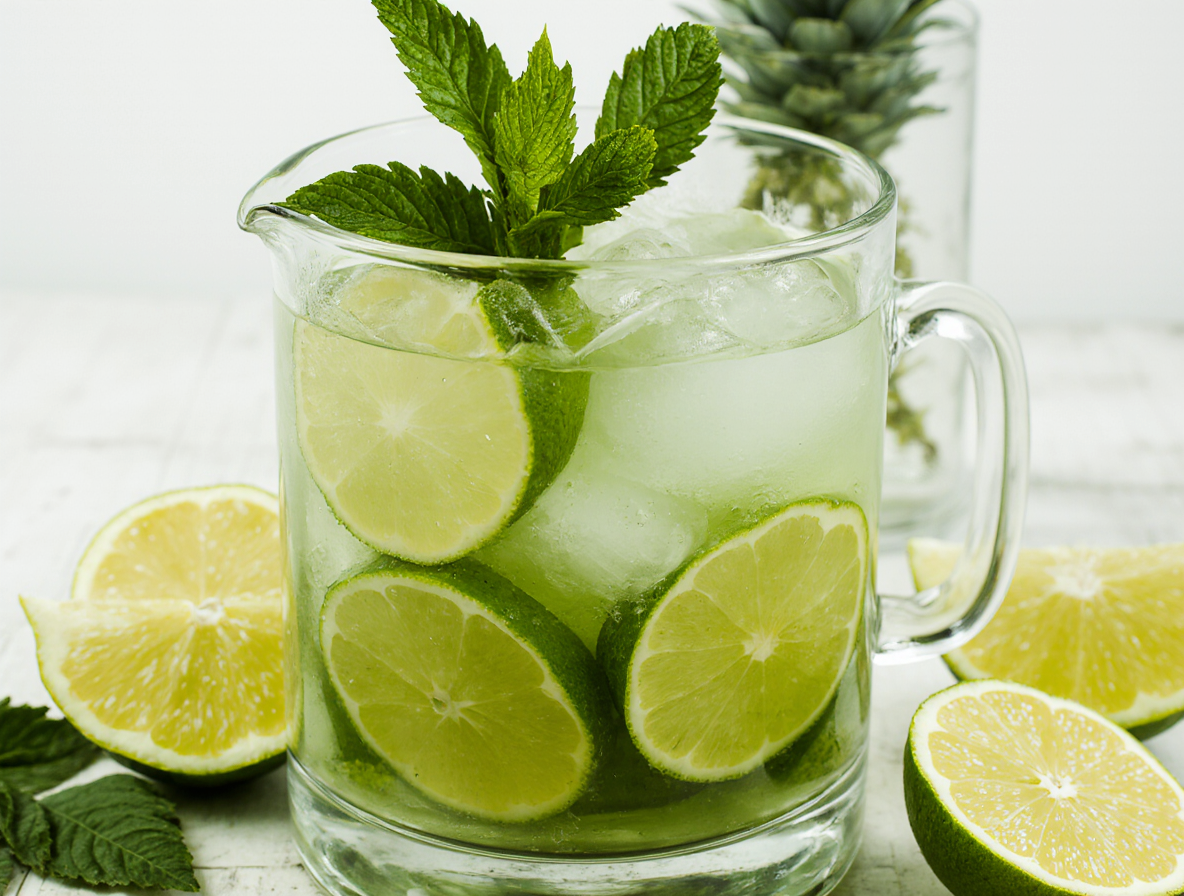How to Make Cold Green Tea: Perfect Tropical Escape for Summer 2025
Learning how to make cold green tea at home is a game-changer for hot summer days. This refreshing beverage not only quenches your thirst but also provides essential electrolytes and antioxidants from natural ingredients like coconut water and green tea.
Besides being incredibly refreshing, cold green tea offers a gentle energy lift throughout the day without the crash that comes from other caffeinated drinks. We’ve discovered that making tropical iced tea at home is surprisingly simple, whether you’re using tea bags or trying the cold brew method. The beauty of tropical tea recipes lies in how fruit flavors generally play well together – combinations of pineapple, coconut, and strawberry create a delightful flavor profile. If you’re hosting a summer gathering, this versatile drink can easily be supplemented with your favorite clear spirit for an effortless cocktail option. In this guide, I’ll share everything you need to know about creating your perfect tropical green tea escape.
Why Cold Green Tea is the Perfect Summer Drink
When summer temperatures soar, cold green tea emerges as the ultimate refreshing beverage for several compelling reasons. In the warmer months, a chilled glass of green tea provides the perfect companion to beat the heat, offering a thirst-quenching treat that’s both delicious and beneficial for your body.
Cold green tea stands out from other summer drinks primarily because of its impressive health profile. This refreshing beverage is packed with beneficial antioxidants that help prevent cell damage and support overall health. Furthermore, unsweetened cold green tea provides significant hydration without unnecessary sugars or additives, making it an excellent choice for staying cool and healthy.
One particularly appealing aspect of cold green tea is its gentle caffeine content. With approximately 35mg of caffeine per 8-oz serving, green tea contains less than a third of the stimulant found in coffee. Interestingly, green tea also contains L-theanine, an amino acid that works synergistically with caffeine to improve both alertness and focus without the jitters. This unique combination provides a milder yet different kind of energy boost compared to coffee.
Cold brewing your green tea offers additional advantages. This method extracts fewer bitter compounds, resulting in a smoother, sweeter cup with less astringency. Moreover, studies indicate cold brewing can actually increase the tea’s antioxidant capacity and catechin levels while reducing its caffeine content even further. For optimal results, researchers recommend steeping for at least 10 minutes to preserve its nutritional value.
The flavor profile of cold green tea is notably refreshing. Many describe it as having a mild yet invigorating taste that’s crisp, clean, and sometimes slightly sweet or earthy. When prepared as a tropical version with additions like coconut water, mango, or pineapple, each sip transports your senses to a sun-soaked paradise.
Beyond taste, cold green tea can support metabolism and potentially aid in weight management. Considering all these benefits, it’s easy to understand why cold green tea deserves its place as the perfect summer beverage.
How to Make Cold Green Tea at Home
Cold brewing has become my favorite method to prepare green tea during summer months. Unlike hot brewing which uses heat, cold brewing relies on time to extract flavors while producing less bitterness and caffeine. This simple process requires minimal equipment and delivers exceptional results.
To begin with, you’ll need just a few basic items: a clean pitcher, bottle, or jar and your choice of green tea. Japanese green teas are particularly ideal for cold brewing as they develop flavor in just 15-20 minutes, compared to other varieties that require 6-8 hours.
For loose leaf tea, use approximately 2 tablespoons per 750ml bottle or 1 tablespoon for a 300ml container. If using tea bags, 6 tea bags work perfectly for 6 cups of water. Loose leaf tea often provides more complex flavors since tea bags typically contain smaller particles of tea.
Here’s how to make your cold brew green tea:
- Fill your container with room temperature or cold water
- Add your measured tea leaves or tea bags
- Gently swirl or move the tea bags back and forth several times
- Seal the container and place in the refrigerator
- Allow to steep according to tea type
Steeping times vary significantly depending on the tea variety. Japanese Fukamushi Sencha needs as little as five minutes, while Hojicha may require up to an hour. For non-Japanese green teas, steep for 6-8 hours.
After steeping, remove the tea leaves or bags and enjoy. Your cold brew green tea will stay fresh in the refrigerator for up to 48 hours, though some sources suggest it can last up to three days.
This method offers several advantages: the resulting brew contains fewer tannins and catechins, creating a smoother, less bitter flavor profile. Additionally, cold brewing extracts less caffeine than hot brewing methods, making it a more gentle option for those sensitive to stimulants.
Tropical Iced Tea Recipe and Flavor Variations
Elevating your cold green tea with tropical flavors creates an extraordinary summer refreshment that transports you to island paradise with every sip. After mastering the basic cold brewing technique, try this delicious tropical variation that combines vibrant fruits with smooth green tea.
For a perfect Tropical Green Tea, start with strongly brewed cold green tea as your base. Alongside the tea, prepare fruit ice cubes by placing small pieces of tropical fruits in an ice cube tray, filling with water, and freezing for at least two hours or until solid. Fruits like mango, pineapple, and coconut work exceptionally well together, creating what some call the “Tropical Refresher” combination.
Here’s a simple recipe to try:
- Prepare 8 ounces of strongly brewed cold green tea using your preferred method
- Add a handful of fruit ice cubes (mango, pineapple, coconut)
- Optionally add freshly grated ginger for a zingy kick
- Sweeten to taste with your preferred sweetener
- Garnish with a sprig of mint
For stunning flavor variations, consider these tropical combinations:
- Mango Pineapple Ginger: Combine 3 small chunks of mango, 2 chunks of pineapple, and ½ inch fresh ginger
- Strawberry Basil: Muddle 3 strawberries, 4 blueberries, and 4 basil leaves
- Watermelon Mint: Mix 4 small watermelon chunks with 5 mint leaves
In essence, these fruity additions aren’t just visually appealing—every melt releases tiny, nutrient-rich surprises into your drink. Consequently, they transform ordinary iced tea into a memorable experience.
Regarding sweeteners, raw honey works wonderfully with green tea, adding about 20 calories per teaspoon coupled with powerful antioxidants called flavonoids. Alternatively, coconut water makes an excellent natural sweetener while adding electrolytes and refreshing flavor.
Your tropical green tea creation will remain fresh in the refrigerator for 3-4 days when stored in a sealed container. This makes it perfect for advance preparation before summer gatherings. Serve in a wine glass with fruit garnish for maximum visual appeal and refreshment.
Conclusion
Cold green tea stands out as a perfect companion for those sweltering summer days ahead. Throughout this article, we’ve explored how this simple beverage offers far more than just refreshment. The gentle caffeine boost paired with L-theanine provides steady energy without the crash, while the abundant antioxidants support overall health.
Making cold green tea at home requires minimal effort yet delivers maximum reward. Cold brewing especially creates a smoother, less bitter taste profile that many find superior to hot-brewed versions. Additionally, this method preserves more of the beneficial compounds while reducing caffeine content – a win-win for health-conscious tea lovers.
The tropical variations we’ve discussed transform an already refreshing drink into something truly special. Fruit combinations like mango-pineapple-ginger or strawberry-basil create flavor profiles that transport you to an island getaway with each sip. Furthermore, these fruit-infused teas make excellent options for summer gatherings, with or without spirits added.
Most importantly, mastering cold green tea at home saves money while giving you complete control over ingredients and sweetness levels. Consequently, you can customize your perfect summer refreshment exactly to your taste preferences.
Summer 2025 might still be on the horizon, but now you have all the knowledge needed to create your own tropical tea escape whenever temperatures rise. So grab your favorite pitcher, select quality green tea, and start experimenting with these refreshing recipes. Your taste buds will certainly thank you.
FAQs
Q1. What’s the best method for making cold green tea at home? The best method for making cold green tea is cold brewing. Simply add green tea leaves or tea bags to cold water, let it steep in the refrigerator for 6-8 hours (or 15-20 minutes for Japanese green teas), then strain and enjoy. This method results in a smoother, less bitter taste with lower caffeine content.
Q2. How can I add tropical flavors to my cold green tea? To create a tropical cold green tea, use fruit ice cubes made with mango, pineapple, and coconut. You can also add fresh ginger for a zingy kick, or try combinations like strawberry-basil or watermelon-mint. Sweeten with raw honey or coconut water for added flavor and nutrients.
Q3. How long does cold brewed green tea stay fresh? Cold brewed green tea can stay fresh in the refrigerator for up to 48 hours when stored in a sealed container. Some sources suggest it can last up to three days, but for the best flavor and quality, it’s recommended to consume within 2-3 days.
Q4. Is cold green tea a healthy summer drink option? Yes, cold green tea is an excellent healthy summer drink. It’s naturally refreshing, low in calories, and high in antioxidants. It provides gentle caffeine and L-theanine for sustained energy without crashes, and can support metabolism and hydration.
Q5. How many cups of cold green tea can I drink daily in summer? While individual tolerances may vary, drinking 2-3 cups of cold green tea per day is generally considered safe and beneficial. If you’re sensitive to caffeine, consider limiting intake in the late afternoon or switching to low-caffeine alternatives like Hojicha or Kukicha.


